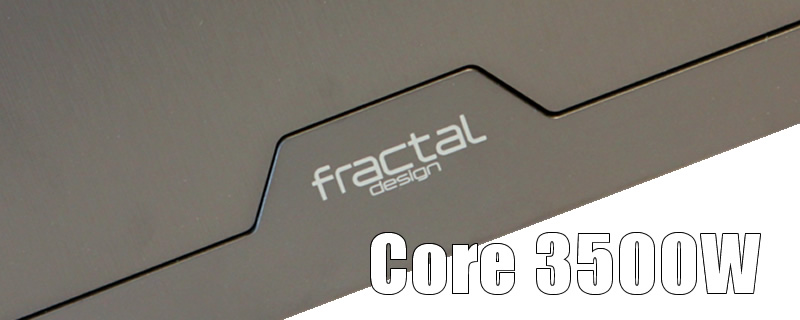Fractal Design Core 3500W Review
Conclusion
If you’re sitting there thinking that £65 is a lot to pay for a “Core” series case then you’ve most likely probably skipped over here to the conclusion without actually reading the body of the review. If however you’ve taken the time to peruse the body of the text then you will know that the Core 3500W is hitting well above its weight.Â
Let’s start with the basics shall we. The Core 3500W is based on the Arc Midi R2 and Define R4 chassis and represents the pinnacle of the new Core X3 range. It is available with a window, as reviewed here, or without for just £5 less. Measuring 233x465x517mm (WxHxD) it appears proportionately a bit wider than most mid tower cases. This appearance of additional width is more than just an illusion though, as Fractal have translated it into a deep interior able to accept CPU tower coolers up to 180mm in height, which is basically pretty much any tower cooler on the market. In addition to providing a perfectly acceptable 2×5.25″ bays, Fractal have also been clever in fitting just the one 4 bay 3.5″/2.5″ drive caddy located at the bottom front corner of the case. Not only does this recognise that with 3TB and 4TB drives readily available there’s no longer a need for 6-8 bays, but it also keeps costs down, and as the mid front area of the case above this caddy is left vacant there’s plenty of room for GPUs up to 430mm long in the top slot, dropping to a still reasonable 295mm long in the bottom three slots.
Of course all the other stuff is there too. There’s support for ATX as well as M-ATX and M-ITX and surprisingly even E-ATX up to 295mm wide. You get seven contrasting vented white PCI slots as well as no less than three monochromatic 140mm fans. If you want to add more fans then there’s room in both the roof and front for 2x120s or 2x240s as well as a 140 in the rear or 120/140 in the base of the case. Inside the case it’s nice to see that Fractal haven’t cheaped out and skipped the rubber grommets as can so often be the case with lower end and even some mid-range enclosures. Two long thin rubber grommeted management holes run vertically down the midline, with a larger PSU hole towards the base. You even get two smaller grommeted holes up towards the roof which are perfect for the 8 pin CPU lead and any fan cables you might want to keep tidy. Speaking of tidy, although there are only six cable tie points, with a good 25mm of space behind the motherboard, even the most inept and lazy of builders should have no excuse for shoddy cable management back there.
So far so good then, but what of build quality. Well we’re not just going to say “well it’s a Fractal case so of course it’s good”. Over the years we’ve seen so many well respected manufacturers miss the boat with a new release, that we treat each case on its own merits. In the instance of the 3500W we’re pleased to say that all is in order.
From an aesthetic standpoint the 3500W is pleasing to the eye. Sleek looks and the brushed Aluminium look front panel identify its lineage, whilst at the same time the slightly more angular lines bring the design up to date. We especially like the angled corners of the large smoked window.
If that was all that Fractal provided in a case at this price point you’d probably be quite happy. Think how you’d feel then when you discovered that it sports native water cooling support in the roof and in the front of the case. And we’re not just talking a cursory not towards a thin 240mm AIO, Oh no. Whip off a few screws and pop out the HDD rack and this baby can take an 80mm thick 280mm radiator in the front in push pull. Not only that but as well as support for 280mm rads with thin fans it can also take any 240mm rad up to 30mm thick in the roof. Let’s say that again.  A £65 case with support for 80mm thick 280mm rad in push pull in the front and slim to medium thickness 240 or 280mm rads in the roof. Now we know why they went to all the trouble of leaving us those 5.25″ bays.
We are though OC3D and as such feel it’s our duty to point out failings no matter how small or inconsequential they may be. There are though only a few, whether they represent an issue for you will be for personal consideration. Our job is merely to point them out. First up is the 3 speed fan controller. Yes we think it’s a great inclusion, but was there really no better place to put it than smack in the middle of the rear panel, so that the wires behind it, of which the black sleeve doesn’t reach up to the insertion causes a rainbow of colours to erupt in front of the eye just inside the side panel window. Secondly there’s the matter of the rear of motherboard mounts for 2×2.5″ drives. Great we say, what a wonderful idea, only they’re straight screw holes rather than lift off brackets which means they can only be added or removed following the removal of the motherboard. Not an issue if it’s a fresh build, but a bit of a bitch if you want to add one at a later date. Last but not least is the matter of the front I/O HD audio connection, the lead for which isn’t nearly long enough and only gets about two thirds of the way to the socket on our test motherboard.
So what of the competition? Well have a look for yourself, for the greater part you’re simply not going to get anything even remotely similar for the sort of money being asked for the 3500W. We think the only real competition out there are the Spec series of cases from Corsair they cost substantially less but still offer native water support in the roof and front, granted this only extends as far as 240mm rads, not the full fat 280s offered by the 3500W. It also has to be said that although the Spec cases are well made they are of a totally different aesthetic to the Fractal, and perhaps lack some of the maturity demonstrated here.
What we have here then is a Core case that doesn’t seem to be aware that it should be displaying only a minimal feature set. Nobody has told this little chap that it’s a cut down budget version of the Arc Midi R2 and Define R4 chassis and certainly he doesn’t seem to have got the memo about basic level cases not having high end water cooling support. Can we forgive its little failings? Yup. Would we buy one? Hell yes, and a recommendation doesn’t come much higher than that.
Â




